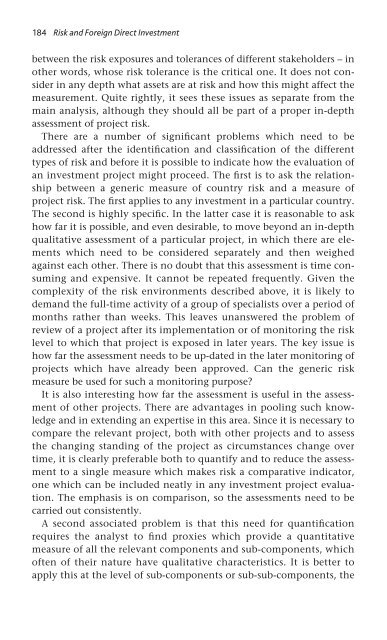Risk and Foreign Direct Investment - Index of
Risk and Foreign Direct Investment - Index of
Risk and Foreign Direct Investment - Index of
You also want an ePaper? Increase the reach of your titles
YUMPU automatically turns print PDFs into web optimized ePapers that Google loves.
184 <strong>Risk</strong> <strong>and</strong> <strong>Foreign</strong> <strong>Direct</strong> <strong>Investment</strong><br />
between the risk exposures <strong>and</strong> tolerances <strong>of</strong> different stakeholders – in<br />
other words, whose risk tolerance is the critical one. It does not consider<br />
in any depth what assets are at risk <strong>and</strong> how this might affect the<br />
measurement. Quite rightly, it sees these issues as separate from the<br />
main analysis, although they should all be part <strong>of</strong> a proper in-depth<br />
assessment <strong>of</strong> project risk.<br />
There are a number <strong>of</strong> significant problems which need to be<br />
addressed after the identification <strong>and</strong> classification <strong>of</strong> the different<br />
types <strong>of</strong> risk <strong>and</strong> before it is possible to indicate how the evaluation <strong>of</strong><br />
an investment project might proceed. The first is to ask the relationship<br />
between a generic measure <strong>of</strong> country risk <strong>and</strong> a measure <strong>of</strong><br />
project risk. The first applies to any investment in a particular country.<br />
The second is highly specific. In the latter case it is reasonable to ask<br />
how far it is possible, <strong>and</strong> even desirable, to move beyond an in-depth<br />
qualitative assessment <strong>of</strong> a particular project, in which there are elements<br />
which need to be considered separately <strong>and</strong> then weighed<br />
against each other. There is no doubt that this assessment is time consuming<br />
<strong>and</strong> expensive. It cannot be repeated frequently. Given the<br />
complexity <strong>of</strong> the risk environments described above, it is likely to<br />
dem<strong>and</strong> the full-time activity <strong>of</strong> a group <strong>of</strong> specialists over a period <strong>of</strong><br />
months rather than weeks. This leaves unanswered the problem <strong>of</strong><br />
review <strong>of</strong> a project after its implementation or <strong>of</strong> monitoring the risk<br />
level to which that project is exposed in later years. The key issue is<br />
how far the assessment needs to be up-dated in the later monitoring <strong>of</strong><br />
projects which have already been approved. Can the generic risk<br />
measure be used for such a monitoring purpose?<br />
It is also interesting how far the assessment is useful in the assessment<br />
<strong>of</strong> other projects. There are advantages in pooling such knowledge<br />
<strong>and</strong> in extending an expertise in this area. Since it is necessary to<br />
compare the relevant project, both with other projects <strong>and</strong> to assess<br />
the changing st<strong>and</strong>ing <strong>of</strong> the project as circumstances change over<br />
time, it is clearly preferable both to quantify <strong>and</strong> to reduce the assessment<br />
to a single measure which makes risk a comparative indicator,<br />
one which can be included neatly in any investment project evaluation.<br />
The emphasis is on comparison, so the assessments need to be<br />
carried out consistently.<br />
A second associated problem is that this need for quantification<br />
requires the analyst to find proxies which provide a quantitative<br />
measure <strong>of</strong> all the relevant components <strong>and</strong> sub-components, which<br />
<strong>of</strong>ten <strong>of</strong> their nature have qualitative characteristics. It is better to<br />
apply this at the level <strong>of</strong> sub-components or sub-sub-components, the




